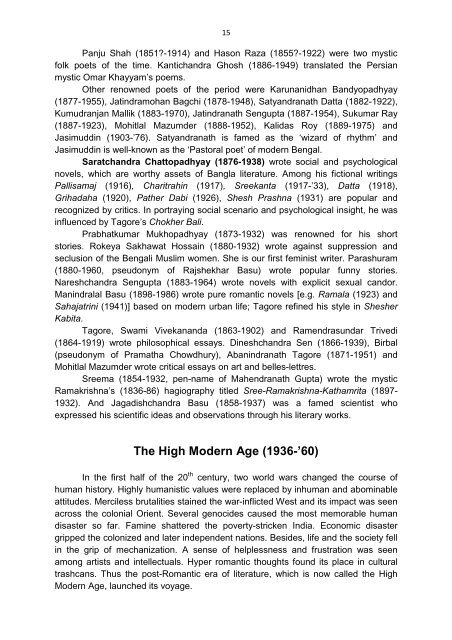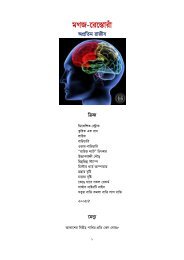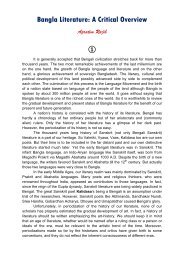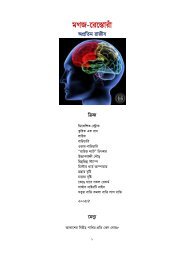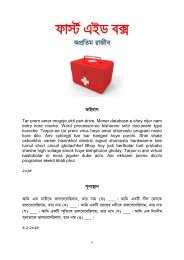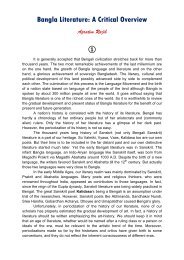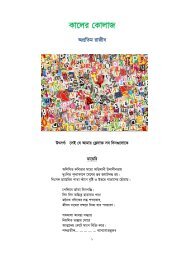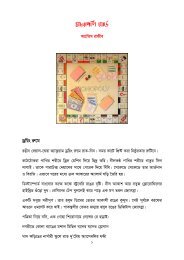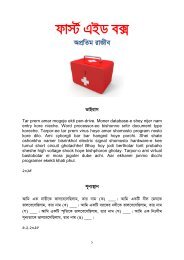Literature-Critique
Create successful ePaper yourself
Turn your PDF publications into a flip-book with our unique Google optimized e-Paper software.
15<br />
Panju Shah (1851?-1914) and Hason Raza (1855?-1922) were two mystic<br />
folk poets of the time. Kantichandra Ghosh (1886-1949) translated the Persian<br />
mystic Omar Khayyam’s poems.<br />
Other renowned poets of the period were Karunanidhan Bandyopadhyay<br />
(1877-1955), Jatindramohan Bagchi (1878-1948), Satyandranath Datta (1882-1922),<br />
Kumudranjan Mallik (1883-1970), Jatindranath Sengupta (1887-1954), Sukumar Ray<br />
(1887-1923), Mohitlal Mazumder (1888-1952), Kalidas Roy (1889-1975) and<br />
Jasimuddin (1903-’76). Satyandranath is famed as the ‘wizard of rhythm’ and<br />
Jasimuddin is well-known as the ‘Pastoral poet’ of modern Bengal.<br />
Saratchandra Chattopadhyay (1876-1938) wrote social and psychological<br />
novels, which are worthy assets of Bangla literature. Among his fictional writings<br />
Pallisamaj (1916), Charitrahin (1917), Sreekanta (1917-’33), Datta (1918),<br />
Grihadaha (1920), Pather Dabi (1926), Shesh Prashna (1931) are popular and<br />
recognized by critics. In portraying social scenario and psychological insight, he was<br />
influenced by Tagore’s Chokher Bali.<br />
Prabhatkumar Mukhopadhyay (1873-1932) was renowned for his short<br />
stories. Rokeya Sakhawat Hossain (1880-1932) wrote against suppression and<br />
seclusion of the Bengali Muslim women. She is our first feminist writer. Parashuram<br />
(1880-1960, pseudonym of Rajshekhar Basu) wrote popular funny stories.<br />
Nareshchandra Sengupta (1883-1964) wrote novels with explicit sexual candor.<br />
Manindralal Basu (1898-1986) wrote pure romantic novels [e.g. Ramala (1923) and<br />
Sahajatrini (1941)] based on modern urban life; Tagore refined his style in Shesher<br />
Kabita.<br />
Tagore, Swami Vivekananda (1863-1902) and Ramendrasundar Trivedi<br />
(1864-1919) wrote philosophical essays. Dineshchandra Sen (1866-1939), Birbal<br />
(pseudonym of Pramatha Chowdhury), Abanindranath Tagore (1871-1951) and<br />
Mohitlal Mazumder wrote critical essays on art and belles-lettres.<br />
Sreema (1854-1932, pen-name of Mahendranath Gupta) wrote the mystic<br />
Ramakrishna’s (1836-86) hagiography titled Sree-Ramakrishna-Kathamrita (1897-<br />
1932). And Jagadishchandra Basu (1858-1937) was a famed scientist who<br />
expressed his scientific ideas and observations through his literary works.<br />
The High Modern Age (1936-’60)<br />
In the first half of the 20 th century, two world wars changed the course of<br />
human history. Highly humanistic values were replaced by inhuman and abominable<br />
attitudes. Merciless brutalities stained the war-inflicted West and its impact was seen<br />
across the colonial Orient. Several genocides caused the most memorable human<br />
disaster so far. Famine shattered the poverty-stricken India. Economic disaster<br />
gripped the colonized and later independent nations. Besides, life and the society fell<br />
in the grip of mechanization. A sense of helplessness and frustration was seen<br />
among artists and intellectuals. Hyper romantic thoughts found its place in cultural<br />
trashcans. Thus the post-Romantic era of literature, which is now called the High<br />
Modern Age, launched its voyage.


